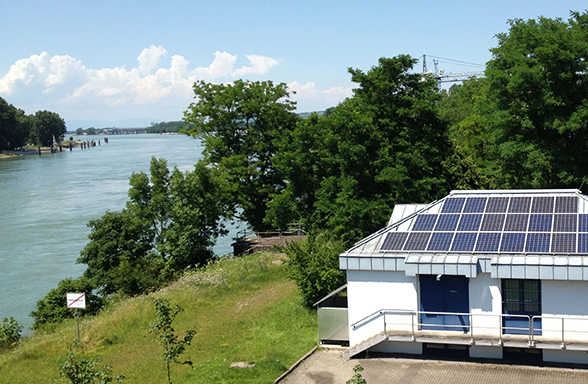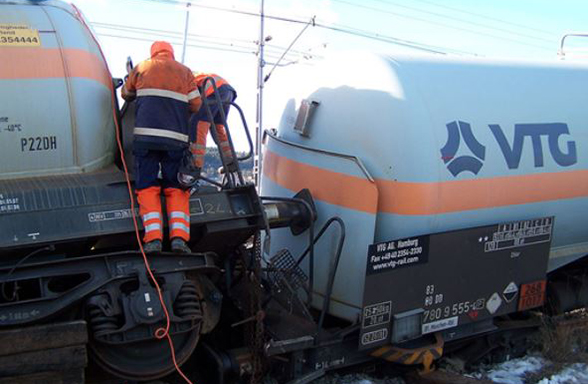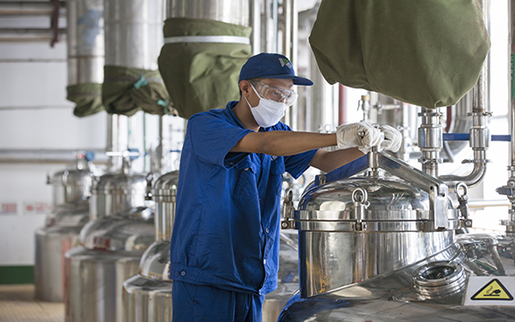The world’s most modern installation for the monitoring of a water body is located in Weil am Rhein in Germany, downstream of Basel. Thanks to the ingenious testing technology available there, timely warnings about contaminant waves can be issued to downstream users – for example drinking-water plants.

As Europe's aquatic lifeline, the Rhine was already subject to international monitoring before the Schweizerhalle fire. However, the International Commission for the Protection of the Rhine (ICPR), which is based in Koblenz (Germany), initially worked on a relatively informal basis. The Berne Convention, which was established in 1963, granted the ICPR status under international law. Two additional chemical and chloride conventions passed in 1976 built on the basis established by the Berne Convention.
‘River radar' in constant use
Following the Schweizerhalle disaster, the ICPR placed great emphasis on the drafting and implementation of water protection measures. The monitoring stations operated by it were also extended and upgraded. The former measuring station near Village-Neuf (Alsace), which was operated by Switzerland's permanent river monitoring body (Nationale Dauerüberwachung Fliessgewässer NADUF), was replaced by the international Rhine monitoring station at Weil am Rhein. Since 1993, this ‘river radar' has been taking round-the-clock samples of water from the Rhine, which are tested routinely once daily for 380 parameters in the laboratory of the Basel-Stadt Cantonal Office for the Environment and Energy (Amt für Umwelt und Energie Basel-Stadt, AUE BS). The samples undergo a kind of retrospective customs check in the Basel environmental laboratory on behalf of the FOEN and the LUBW, its partner authority in the German federal state of Baden-Württemberg, which operate the Rhine monitoring station jointly,.
Many different substances recorded
Today, the measurements no longer merely cover conventional parameters like the water level and temperature and the levels of selected inorganic contaminants like heavy metals, nitrate and phosphate: today, the levels of around 680 individual substances are regularly recorded, including pharmaceutical residues and x-ray contrast media. Thanks to the daily checks, it has even been possible to detect unknown organic substances since 2013. This kind of monitoring inevitably leads to the discovery of environmental pollution: for example, in 2006, thanks to the daily tests it was possible to discover that the Rhine had been contaminated with 4.3 tonnes of toxic dimethylaniline. The company responsible for the pollution was unaware of it. Based on the subsequent clarification of the source of the contamination, the company took the necessary measures and the route through which the substance had entered the water was eliminated. The following general rule applies: once excessively high concentrations of a substance have been detected in the water, the substance is no longer used in production or only detectable in considerably lower concentrations.
It may be concluded from the data produced by the Rhine monitoring station that in 2015 the Rhine flowing through Basel contained 18.1 tonnes of active pharmaceutical ingredients, 8.7 tonnes of x-ray contrast media, 1.8 tonnes of pesticides and 22.1 tonnes of artificial sweeteners. All of these compounds are classified as organic trace substances, the total load of which contained in the river was 153 tonnes.
Drinking water for 22 million people
If the levels of individual pesticides or active pharmaceutical ingredients reach the alert threshold of 0.3 micrograms per litre (µg/L) - that is one millionth of a gram - the Rhine monitoring station triggers an international alert. The primary objective here is to protect the city of Basel's drinking-water processing system and the downstream waterworks with their approximately 22 million consumers from undesirable contaminants. Based on the long-standing mean flow rate of the Rhine in Basel of a good 1000 cubic metres per second, a contaminant content of 0.3 µg/L corresponds to a daily load of 27 kg.
It may be concluded from the data produced by the Rhine monitoring station that in 2015 the Rhine flowing through Basel contained 18.1 tonnes of active pharmaceutical ingredients, 8.7 tonnes of x-ray contrast media, 1.8 tonnes of pesticides and 22.1 tonnes of artificial sweeteners. All of these compounds are classified as organic trace substances, the total load of which contained in the river was 153 tonnes.

Alerting: providing information in good time, transparently and across borders
The alerting of the local population and of affected locations abroad did not function well in the case of the Schweizerhalle fire. The International Commission for the Protection of the Rhine (ICPR) also assumed a leading role in this area: at its 8th conference of Rhine ministers of 1987 it was decided that the International Warning and Alert Plan Rhine should be developed, tested and coordinated with the alerting and alarm plans of other organisations active in the Rhine catchment area.
Information - from Switzerland to Holland
If a major accident were to arise on the Rhine now, one of the seven principle alert centres between Basel and Arnheim (Holland) would transmit the alert to all downstream centres, local offices and water suppliers. A form containing detailed specifications about how information about the nature of the accident, the substance(s) involved, the volume and the duration of discharge, etc. should be processed ensures that the relevant bodies are provided with consistent information that will not cause any misunderstandings.
The International Warning and Alert Plan Rhine is complemented by the Rhine flow time model. In the event of a sudden discharge of contaminants into the river, this computer model is able to calculate how the contaminant wave will spread - indispensable information when a timely response to pollution is required.
Major Accidents Ordinance also targets the transportation of dangerous goods
Toxic, explosive and otherwise highly reactive substances do not only pose a risk in local stationary contexts, they also - and particularly - harbour risks during transport. For this reason, from 1999 the Federal Office of Transport (FOT), the authority responsible for overseeing the transport of dangerous goods by rail, initiated a cooperative process with the FOEN, the Swiss Federal Railways (SBB) and the Bern-Lötschberg-Simplon railway company (BLS) for identifying the risks arising from the transport of dangerous goods like propane or petrol throughout the entire railway network.
The corresponding process for the motorways has been implemented by the Federal Roads Office (FEDRO) since 2008; FEDRO has also been implementing a screening programme since 2013. The screenings established the baseline for identifying measures and reducing the risks to the population, both residents and transport users.
The transport of dangerous substances by road and rail in Switzerland no longer poses unacceptable risks to human life today since measures were taken by all of the responsible instances - from the inspection authorities to the transport operators - to alleviate the potentially unacceptable risks highlighted by the network-wide risk assessment. From 2015 to 2016, the FOEN and a broad-based working group focused particularly intensively on the regular transports of chlorine gas by rail from Geneva into the canton of Valais.
Joint declaration for chlorine gas transport
The working group's activities ultimately led to the compilation of a joint declaration which was signed by scienceindustries, the SBB, the VAP (Verband der verladenden Wirtschaft), the FOT and the FOEN in September 2016. The cantons most affected by this transport, Geneva, Vaud, Valais and Basel Stadt, were also involved in the process. The objectives and risk reduction measures were agreed in this second joint declaration. The adopted measures include provisions for better equipped tank wagons, slower travelling speeds and other operational precautions. In addition, the industry undertakes to verify whether its transports could not be routed through more sparsely populated areas. An initial joint declaration was signed in 2002.
Monitoring of gas and oil pipelines
The risk assessment process for pipeline installations is not as advanced as for transport routes. Gas and oil pipelines were not included in the scope of application of the MAO until 2013. The risks associated with these installations are currently being assessed and operators must submit the corresponding reports by 1 April 2018.
The transportation of dangerous goods obviously poses a risk to both human life and the environment. Although the risk assessments are already available and the extent to which surface water bodies and groundwater could be affected by a major accident is known, definitive criteria for assessing the environmental risks arising from network-based transport installations are still lacking. A working group chaired by the FOEN is in the process of defining these criteria and is expected to complete its work some time in 2018. It is entering new territory here as this kind of risk is not surveyed in any other country in this quantitative form. International experience in this area is still largely lacking.

Efforts bear fruit
Environmental pollution cannot be halted at borders and economic cooperation also operates on an increasingly globalised basis. This makes the definition of - and compliance with - internationally binding principles for the management of major accidents all the more urgent.
Efforts have also been made at global level to counteract major accident risks. In 1992, the United Nations Economic Commission for Europe passed the Convention on the Transboundary Effects of Industrial Accidents, which entered into force in 2000 following ratification by 16 states. It has since been formally signed by around 40 states and the European Union; Switzerland deposited its instrument of ratification in 1999.
Chemical risks: supporting less developed countries
The main focus of the work being done in this area is the UNECE's internationally supported Assistance Programme, which supports countries in Eastern Europe, the Caucasus, south-east Europe and central Asia in laying the foundations for the prevention and management of chemical accidents. This action is being taken into consideration due to the numerous risk-prone chemical operations, heavy industry and, in part, large oil depots located in these regions. In addition, numerous guidelines for the safe handling of chemicals and other industrial risks have been developed under the umbrella of the Industrial Accidents Convention. Switzerland has been actively involved in this support programme for many years and shares its experience in the management of chemical risks
Last modification 28.10.2016





